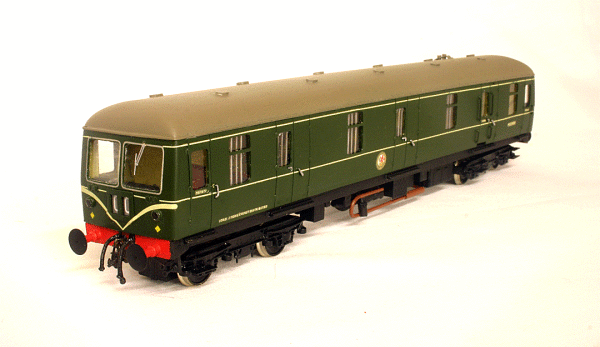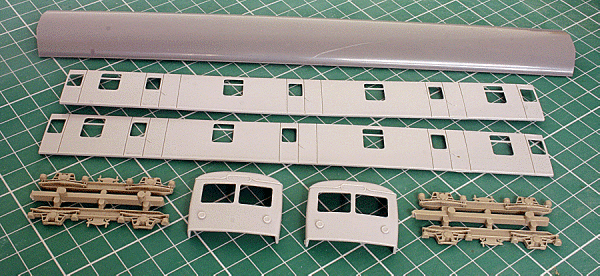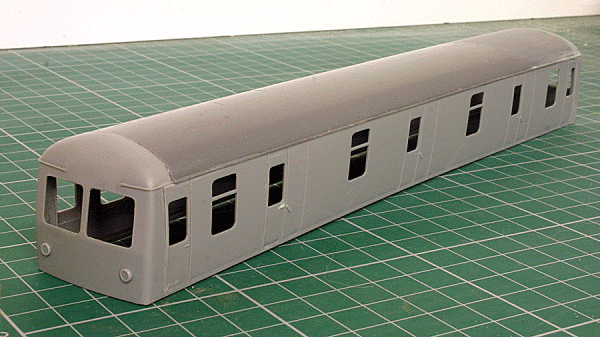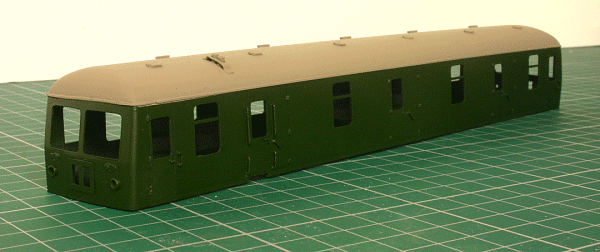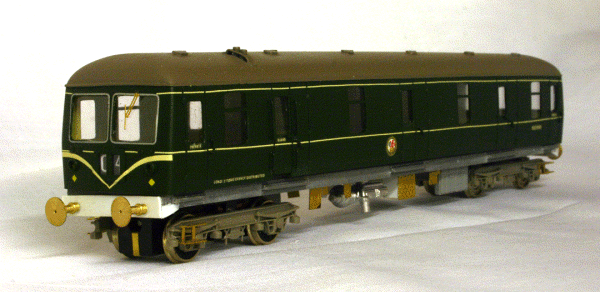Steve Johnson Modelmaker
|
Class 129 Cravens Diesel Parcel Unit
Cravens Class 129 Cravens built three diesel parcel units which entered service on the London Midland Region. They had the standard Cravens cab and were built on the short chassis. Although they had two AEC 150hp engines with standard transmission, the carried the Yellow Diamond coupling code. This was to enable them to work with the original Derby Lightweights in the North-West. They were all withdrawn by 1973, but one, M55997, went to the Railway Technical Centre in Derby and became a test bed for hydraulic transmission. It was renumbered RDB975385 as Laboratory 9 - HYDRA. My take on this unit is the DC Kits plastic kit. Unfortunately by the time I got around to ordering one, the kit had been discontinued! However, Charlie managed to find me some cab ends, body sides and roof as well as some detail parts and I will construct the unit from these. Thanks Charlie!
Body parts as supplied Below is an image of the assembled bodyshell. Being a plastic kit, it is quick to get to this stage using Butanone solvent adhesive. As can be seen, the destination blind window above the cab windows has been removed as the DMLV did not have them. The rainstrip has yet to be continued across the gap.
Body assembled and the destination indicator removed Progress was a bit slow at first, but the Class 129 is getting towards completion. As there was not any chassis/floor provided with this kit, I initially made my own plasticard version. However, this was not very successful and I eventually acquired the correct chassis from DC Kits. This made fitting the Black Beetle motor bogie much easier at the correct height and the trailing bogie. Additional pick ups are provided on the trailing bogie. Three cross braces were fitted to the body, ends and middle, to provide suitable points to secure the chassis to the body. This is done with self tapping screws. The existing door handles were filed off and separate etched brass handle and hinges from the MJT range were fitted. Handrails were also fitted to the Guards door area. Cravens pattern roof vents from the Craftsman Models range were fitted on the roof. The exhaust, which on a Cravens unit exits through the body and roof, were made from thin brass tube and strip. The rain strip across the cab front was also added, being made from plasticard strip. The Two character indicators are from the Craftsman Models range. The unit will feature working lights, so the moulded versions were drilled through to allow 2mm Lighthouse LED's to be fitted. I was going to cheat here a little by fitting bicolour red/white ones, but in the event, I fitted white ones as the rear carried a separate tail lamp. The headcode also lights up by using some nano LED's mounted in plasticard box affair behind the headcode panel. The headcodes themselves were printed to the correct size using my computer and fixed behind the clear acetate 'glass'.
Body painted This is how the body looks just after painting was completed. A little tidy up is necessary before applying the transfers. Fox Transfers make a complete set suitable for the Class 129.
Body complete with chassis still under construction Work on the chassis is now in hand fitting the engines and other under floor boxes. These are supplied mostly as etches in the kit, but look a bit 2 dimensional for me, so I padded them out a bit to give more depth. Other underframe detailing included fitting exhaust pipes and silencers. With the underframe complete, it was sprayed black. The exhaust was picked out in a rusty bauxite colour and the beams in red. More detailing was fitted in the form of vacuum pipes, screw couplings and horns. As I intend this to be a standalone model, I did not fit my usual Alex Jackson couplings. Some rudimentary internal detail was fitted in the form of partitions and window grilles. The cabs have a bit more detail including the rather visible handbrake wheel. With the model complete, it was time to fit a suitable decoder and wire everything up. I used a LaisDCC 860012 with the plug chopped off. This decoder does have a 'stay alive' option, but as the unit is eight wheel pick up, I decided not to use it. The Black Beetle motor bogie required the red and black wires unsoldering from the pick ups. New wires were added to the pick ups and joined to the correct wires on the other bogie. The original wires on the motor bogie were extended to reach the decoder. With the lighting wires also in position, the decoder was wired up. So, that's another unusual DMU to add to add to the fleet.
Silver Fox Models offer a RTR version of this class, either as a DMLV or Laboratory 9 - HYDRA. Craftsman Models currently produce a conversion kit based on the Lima Class 117. DC Kits did offer a kit of this class. MTK also offered a kit of this class. Anbrico produced a kit of this class some years ago. Brittania Pacific Models make a RTR model of this class in various liveries. Curiously, the Brittania Pacific version seems to have the centre destination indicator present above the cab windows!
|
|
